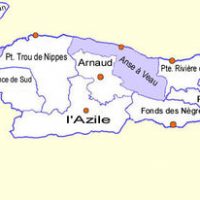Plaisance Du Sud

Plaisance-du-Sud is a commune in the Anse-à-Veau Arrondissement, in the Nippesdepartment of Haiti. Population 27,000 (2015)
One of the pleasure spots on the northwestern coast of Haiti’s peninsula, Plaisance-du-Sud, its English name translating to “Southern Pleasure”. Located to the south of Petit-Trou-de-Nippes, its beaches are made of sugar-white sands affronting the aquamarine Caribbean Sea. Maritime events dominate the waterfront area with wind- and wave-surfing and sea-vessel racing. Docking slips are plentiful for both small and large sea vessels.
Plaisance-du-Sud has teeming marine life, schools of fish, which live beneath the coastal waters unharmed. Although the province of smaller fish, sometimes larger fish appear in the glassy waters offshore, having taken the wrong route to their next feeding destination.
From a connecting ramp, at Cavaillon level of Route Nationale 2, a bumpy and dirt road, on a fork to the north called “Route Trois Mango / Bonne Fin”, leads to Plaisance-du-Sud. It is a valley encircled by the Morne Geffrard, mardi gras, to the south; tadis, Sudre, clement in the west; mingot, Gerin, Bellevue, Gauthier, north; nellier, vassal, cenacle, to the east. Located 171km from P-au-P, the capital; between the Baradères commune to the west; Cavaillon, to the south, L’Asile to the east; Petit-Trou-de-Nippes, in the north, and Anse-à-Veau in the northeast, it is an enclave between the departments of the south, the Nippes and the big cove (Grand Anse).
This town contains mountains and plains. It is traversed by the Rivière de Bois Coupé and de Lexandre.
This commune has 3 communal sections:
1st section Ti-François
2nd section Pine Cove
3rd section Vassale
The southern pleasure community is largely a valley, the altitude varies from sea level to 341 m above sea level.
Economy: The chief income-generating activity in Plaisance-du-Sud is fishing, a year-round task necessary to keep food on the table for Haitian families living there.
Infrastructure: The road system in Plaisance-du-Sud is pitiful as it is in virtually all small towns across Haiti. Unpaved and littered with rocks and undergrowth, they are impossible to navigate by car. Travelers must walk to wherever it is they want to end up. Four-wheel vehicles that transport tourists and can weather the rugged terrain sometimes pick up residents when there is room.
This municipality of approximately 27,000 inhabitants is endowed with the basic administrative structures: court of peace, registry office, the Town hall, health center, municipal police, national police, primary, secondary and professional schools.

